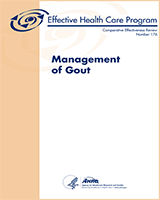From: Executive Summary

Management of Gout [Internet].
Comparative Effectiveness Reviews, No. 176.
Shekelle PG, FitzGerald J, Newberry SJ, et al.
Rockville (MD): Agency for Healthcare Research and Quality (US); 2016 Mar.
NCBI Bookshelf. A service of the National Library of Medicine, National Institutes of Health.
